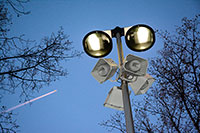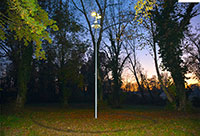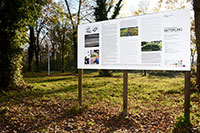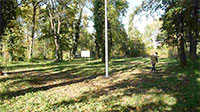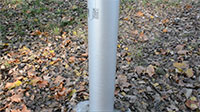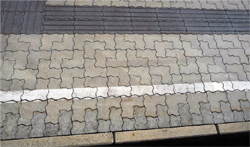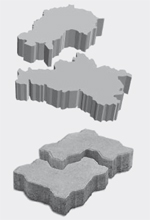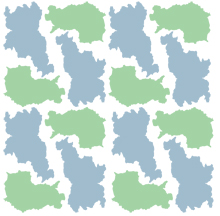Hinüber sagt man jetzt nur mehr wegen der Brücke. Eine Grenze ist ja nicht. Im Kopf, denk ich, ist noch eine Grenze. Aber es haltet dich keiner mehr auf.
Tja čez zdaj rečejo zgolj zaradi mostu. Saj meje ni. V glavi, menim, je še vedno meja. Toda ustavil te ne bo nihče.
To cross over they say only due to the bridge. There is no border anymore. In the head, I think, is still a border. But no one will stop you. (Albert Pall)
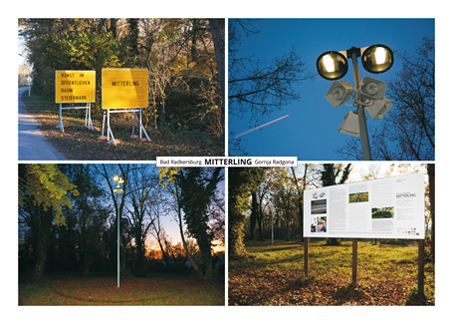
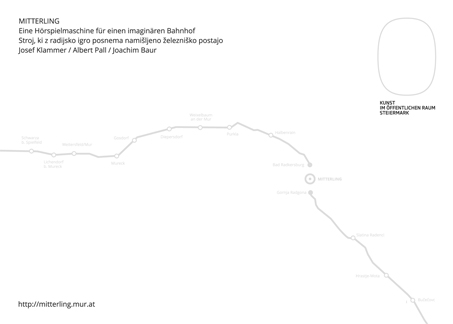
Grenzziehungen, deren Geschichte, mögliche Überwindung und Durchlässigkeit, oder die Kooperationsbereitschaft von Nachbarstaaten sind hochaktuelle Themen.
Eine konkrete ehemalige Verbindung, die durch nachfolgende politische Grenzziehung unterbrochen wurde, finden wir zwischen der südlichen Steiermark und Slowenien: Spielfeld-Straß und Luttenberg (heute Ljutomer) waren einst durch eine Bahnlinie verbunden. 1885 eröffnete der erste Teilabschnitt bis Radkersburg, 1890 erfolgte die Inbetriebnahme des Wegstückes bis Luttenberg.
|
Določanje mej, njihova zgodovina, njihovo morebitno premagovanje in njihova prepustnost ter pripravljenost sosednjih držav do sodelovanja so danes aktualne teme.
Konkretna povezava, ki jo je prekinila politično določena meja, je obstajala tudi med avstrijsko južno Štajersko in Slovenijo: Špilje/Spielfeld-Straß in nekdanji Luttenberg, danes Ljutomer, je nekoč povezovala železniška proga. Leta 1885 so odprli prvi del proge do Radgone/Radkersburga, leta 1890 pa je začela obratovati proga do Ljutomera. |
The drawing of borders, their history, how they may be overcome and their porosity, or the willingness of neighbouring states to cooperate are highly topical issues. A real-world former connection severed by subsequent political border-drawing can be found between southern Styria and Slovenia: Spielfeld-Straß and Luttenberg (now Ljutomer) were once connected by a railway line. The first section, running to Radkersburg, was opened in 1885, with the section to Luttenberg taken into operation in 1890. |
|
Mit Ende des Ersten Weltkriegs fiel der südliche Teil der Steiermark an Jugoslawien, wodurch auch die Eisenbahnstrecke bei Kilometer 32,5 geteilt wurde. Nach dem Ende des Zweiten Weltkriegs wurde der Abschnitt zwischen Radkersburg und Gornja Radgona am 17. April 1945 eingestellt und später abgetragen. Auf dem heute slowenischen Teil gibt es noch Güterverkehr.
Vor dem Hintergrund des Verständnisses der Steiermark als Brückenbauer zwischen Ost und West sowie zwischen Nord und Süd positionierte sich das Projekt Mitterling am namensgleichen Ort in der Mitte des abgebauten Teilstückes in künstlerischer Auseinandersetzung mit diesem Missing Link und der kulturellen Verbindung von Steiermark und Slowenien.
Winkelverbundsteine
Die Projektidee war in Kooperation mit dem Verein Neue Radkersburger Bahn, dem Kunstprojekt Zollamt sowie den Gemeinden Bad Radkersburg und Gornja Radgona entstanden und wurde gemeinsam mit dem Institut für Kunst im öffentlichen Raum Steiermark weiterentwickelt und umgesetzt.
Als Hörspielmaschine für einen imaginären Bahnhof hatten Josef Klammer, Albert Pall und Joachim Baur eine Installation entwickelt, die für einen Pufferschluss zwischen den getrennten Teilstücken plädiert.
Inmitten zweier unterschiedlicher internationaler Fahrverbotssignale auf österreichischer und slowenischer Seite wurden auf einem Masten Bahnsteiglautsprecher und Bahnsteigleuchten montiert, die in alle vier Himmelsrichtungen ausgerichtet waren. Um den Bahnsteigmasten führte ein kreisrunder Weg, der auf das international gültige Logo (Kreis und Mittelpunkt) für Zentrum, Fundort und bedeutungsvolle Markierung verwies.
Fünf Stimmen waren hier zu hören, deren Texte im Zufallsmodus stets neue Kombinationen ergaben: eine weibliche und eine männliche Stimme, die sowohl in Deutsch als auch in Slowenisch sprachen und eine synthetische, die in englischer Sprache dem Duktus der Informationsdurchsagen auf Bahnhöfen ähnelte. Die Texte von Albert Pall, gebaut nach dem System „call and response“, wurden wie bei einem Kartenspiel im Zufallsmodus gemischt und entwickelten ein unendliches Hörspiel, in dem die männliche, weibliche und synthetische Stimme in Dialog traten.
Inhaltlich setzte sich der Text mit der Möglichkeit eines bestehenden Bahnhofes auseinander. So wurden in Satzbausteinen Gedanken angesprochen und initiiert, die sich mit Bahnhof und dessen Umgebung, Bewegung, Weg, Begegnung, Trennung, Austausch etc. beschäftigten und Kopf und Körper berührten.
Den Klang entwickelte Josef Klammer gemeinsam mit Schülerinnen und Schülern des BORG Radkersburg. In 4 x 128 Klangfragmenten wurden Möglichkeiten von Klängen, die für einen Bahnhof in Frage kommen, ebenfalls im Zufallsmodus abgerufen. Die Musik, der Sound generierte sich somit unmittelbar vor Ort.
Der fixe Ort Bahnhof steht in klassischer Weise für Transit, ist gleichzeitig ein Nicht-Ort, also eine Utopie. An ihm finden zufällige Treffen und Trennungen statt, er steht für Aufbruch, Ankommen, Unsicherheit und Hoffnung.
Das Projekt Mitterling als Realisierung der Vorstellung eines solchen Ortes lässt nicht nur die reale historische Verbindung und eine mögliche zukünftige erahnen. Von Joachim Baur als Idee und gleichzeitig als Baustellen-Environment und auch als flüchtiger und gleichzeitig konkreter Raum angedacht, waren wir hier eingeladen, uns auf visuelle und akustische Impulse und Kompilationen, die auf poetische Weise geschaffen wurden, einzulassen. Neben Erinnerung an oder Assoziation mit Aufbrüchen, Träumen oder Gefahren erfuhren wir in unmittelbarer Gegenwart Möglichkeiten der Erweiterung des eigenen Bewusstseins und Denkens.
Elisabeth Fiedler, im Jahrbuch 2015
|
S koncem prve svetovne vojne je južni del Štajerske pripadel Jugoslaviji, železniška proga pa se je med državi razdelila na 32,5 kilometru. Po koncu druge svetovne vojne so 17. aprila 1945 progo med Radgono in Gornjo Radgono zaprli ter jo kasneje tudi odstranili. Na delu proge, ki danes leži v Sloveniji, še poteka tovorni promet.
Ob razumevanju Štajerske kot graditeljice mostov med Vzhodom in Zahodom ter Severom in Jugom, je projekt Mitterling umeščen v istoimenski kraj, na sredo odstranjenega dela proge, in z umetniškega vidika obravnava ta Missing Link (manjkajoči člen) ter kulturno združuje avstrijsko Štajersko in Slovenijo.
Projektna ideja je nastala v sodelovanju z združenjem Neue Radkersburger Bahn (Nova radgonska železnica), umetniškim projektom Zollamt (Carina) in občinama Bad Radkersburg ter Gornja Radgona, razvili in uresničili pa smo jo s pomočjo avstrijskega Inštituta za umetnost v javnem prostoru.
Josef Klammer, Albert Pall in Joachim Baur so razvili instalacijo, ki si prizadeva ublažiti prekinitev proge: stroj, ki z radijsko igro posnema namišljeni kolodvor.
Sredi dveh različnih mednarodnih znakov za prepoved vožnje, ki stojita na avstrijski in slovenski strani, so na drog montirani peronski zvočniki in peronske luči, ki so usmerjene proti severu, jugu, vzhodu in zahodu. Okoli peronskega droga vodi krožna pot, ki predstavlja mednarodno veljavni znak za center (krog in točka v sredini), najdišče in druge pomembne oznake.
Kotni kompoziti
Iz zvočnika je slišati pet glasov, njihova besedila pa z naključnim kombiniranjem ustvarjajo vedno nove kombinacije. Dva ženska in dva moška glasova govorita v nemščini in slovenščini, sintetični glas pa govori v angleščini in spominja na informacijska zvočna sporočila na železniških postajah. Besedila Alberta Palla so sestavljena po sistemu »call and response« in se kot pri igri s kartami naključno mešajo ter tvorijo neskončno zvočno igro, v kateri poteka dialog med moškimi in ženskimo glasovi ter sintetičnim glasom.
Vsebina besedila obravnava možnost obstoja železniške postaje. Izgovorjeni stavki vsebujejo in spodbujajo razmišljanja o železniški postaji in njeni okolici, premikanju, poti, srečevanjih, ločitvah in izmenjavi ter se dotaknejo tako glave kot telesa.
Železniška postaja kot fiksni kraj na klasični način predstavlja tranzit, a je istočasno tudi kraj, ki ne obstaja, torej utopija. Tukaj potekajo slučajna srečanja in ločevanja, postaja pa predstavlja odhajanje, prihajanje, negotovost in upanje.
Projekt Mitterling, ki je realizacija takšnega kraja, nam ne omogoča le, da se spomnimo realne zgodovinske povezave in zaslutimo morebitno povezavo v prihodnosti. Ker si ga je Joachim Baur zamislil kot idejo in okolje, ki deluje kot gradbišče, in je zato bežen ter hkrati tudi konkreten prostor, nas projekt vabi, da se prepustimo vizualnim in akustičnim impulzom in kompilacijam, ki so bile ustvarjene na poetični način. Poleg tega, da nas spominjanja ali asociiranja na odhajanje, sanjarjenje ali nevarnost, lahko z njegovo pomočjo v sedanjosti izkusimo možnosti širjenja naše zavesti in mišljenja.
Elisabeth Fiedler, knjižica programa 2015
|
At the end of the First World War, the southern part of Styria fell to Yugoslavia, thus causing the railway line to be divided at kilometre 32.5. After the end of the Second World War, the section between Radkersburg and Gornja Radgona was closed down on 17 April 1945 and later demolished. Goods trains still run on the Slovenian part today.
Understanding Styria as a bridge-builder between East and West and between North and South, the Mitterling project was situated in the place of the same name in the middle of the demolished section with the aim of engaging in an artistic examination of this missing link and the cultural connection between Styria and Slovenia.
The idea for the project came about in cooperation with the Neue Radkersburger Bahn association, the Zollamt art project, and the municipalities of Bad Radkersburg and Gornja Radgona and was refined and carried out in collaboration with the Institute for Art in Public Space Styria.
In the form of an audio drama machine for an imaginary railway station, Josef Klammer, Albert Pall and Joachim Baur had devised an installation that argues in favour of closing the gap between the separate sections.
Between two different international stop signals on the Austrian and Slovenian side, platform loudspeakers and platform lights were mounted on a post facing all four points of the compass. A circular path ran around the platform post alluding to the international symbol (a circle with a point in the middle) for centre, the site of a find, and a point of interest.
Five voices could be heard, their words constantly and randomly creating new combinations: a female and a male voice speaking both in German and Slovene and a synthetic voice speaking in English in the style of announcements heard at railway stations. The words written by Albert Pall based on the “call and response” system were randomly shuffled as if in a card game to create an infinite audio drama in which male, female and synthetic voice engaged in a dialogue with each other.
In terms of content, the text dealt with the possibility of an existing railway station. Sentence building blocks were used to address and initiate thoughts dealing with the railway station and its surroundings, movement, path, encounter, separation, dialogue, etc., touching both, the mind and the body.
The sound was developed by Josef Klammer together with students from the BORG Radkersburg school. 4 x 128 Klangfragmente also involved randomly retrieving possible sounds for a railway station. The music and the sound were thus generated directly on site.
Angle composites, design pattern
A fixed location, the railway station traditionally symbolises transit, and is at the same time a non-place, that is to say, a utopia. Chance meetings and separations occur here, it stands for departure, arrival, uncertainty and hope.
As a realisation of the idea of such a place, the Mitterling project not only hints at the real historical connection and a possible future connection. Conceived by Joachim Baur as an idea and, at the same time, as a building site environment and also as an ephemeral and concrete space, we were invited here to engage with poetically generated visual and acoustic impulses and compilations. In addition to memories of or associations with departures, dreams or dangers, in the immediate presence we experienced possibilities of expanding our own consciousness and thinking.
Elisabeth Fiedler, almanac 2015 |
||
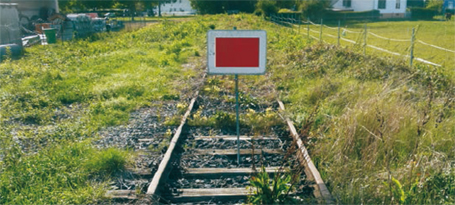
Streckenende | Konča pot | Track-end | Bad Radkersburg
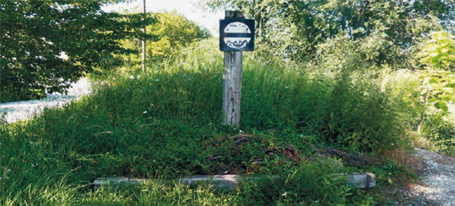
Streckenende | Konča pot | Track-end | Gornja Radgona

 Home
Home